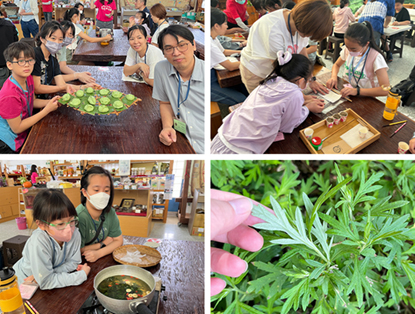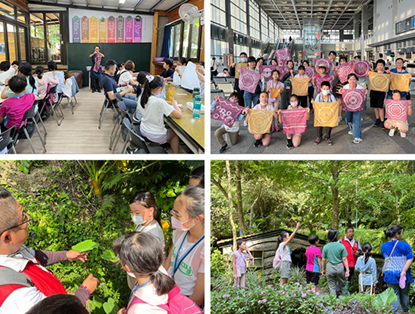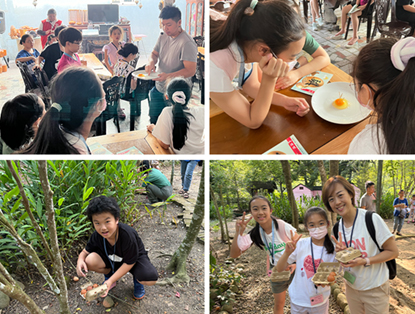Sketch of Archilife Study Tour, May 2024Date: 2024-06-24
Section: Activity |  2024年5月18日由呂明澐小姐帶領23位祐生見習生及家長們,至苗栗三義進行艾草食作暨藍染體驗之旅。上午至雙潭休閒農業區旅客服務中心,由社區導覽員透過簡報介紹雙潭地區的生態環境,當地氣候變化明顯,桃李、柑橘等水果特別可口,也促進周邊生成許多各具特色的農場。接著介紹本次活動主題-艾草,其對氣候和土壤的適應力強,對人體又有清熱解毒的藥性,故從藥用到食品都可見到艾草的身影。然而擁有毒性的銀膠菊,因其外貌和艾草相似容易混淆,導覽員特地帶領大家至臨近的種植區近距離觀察艾草,以灰白色有絨毛的葉背和搓揉時產生濃香的辨別度,讓眾人有更深入的了解。隨後進行艾草豬籠粄、捲艾條、煮艾草茶等手作課程及品嚐,軟糯的艾草糰包覆著鹹香的菜圃,搭配清香的紅棗艾草茶,由內而外使見習生們感受到滿滿的成就感。 2024年5月18日由呂明澐小姐帶領23位祐生見習生及家長們,至苗栗三義進行艾草食作暨藍染體驗之旅。上午至雙潭休閒農業區旅客服務中心,由社區導覽員透過簡報介紹雙潭地區的生態環境,當地氣候變化明顯,桃李、柑橘等水果特別可口,也促進周邊生成許多各具特色的農場。接著介紹本次活動主題-艾草,其對氣候和土壤的適應力強,對人體又有清熱解毒的藥性,故從藥用到食品都可見到艾草的身影。然而擁有毒性的銀膠菊,因其外貌和艾草相似容易混淆,導覽員特地帶領大家至臨近的種植區近距離觀察艾草,以灰白色有絨毛的葉背和搓揉時產生濃香的辨別度,讓眾人有更深入的了解。隨後進行艾草豬籠粄、捲艾條、煮艾草茶等手作課程及品嚐,軟糯的艾草糰包覆著鹹香的菜圃,搭配清香的紅棗艾草茶,由內而外使見習生們感受到滿滿的成就感。
For the study tour of May 18, 2024, Ms. Lu Ming-yun led 23 ARF interns and their parents on a trip to Sanyi, Miaoli, to learn about eating mugwort and indigo dyeing. At Travel Service Center of Shuangtan Agritourism Area, everyone was introduced to the ecological environment of Shuangtan area through a briefing. Due to distinct weather changes in the locality, fruits such as peach, plums and citruses are especially delicious, giving rise to many unique farms in the surrounding. The tour guide explained that mugwort is highly adaptable to the climate and soil, and helps to relieve heat and remove toxin in the human body, which is why mugwort is commonly found in medicine and food. As mugwort looks similar to the toxic Santa Maria feverfew, everyone was led to the mugwort plantation to observe the herb up close, learning that the back of its leaves has grayish-white fine hair and rubbing the leaves produces a strong fragrance. In the DIY activities afterward, interns made caozaiguo, rolled moxa sticks and made mugwort tea, feeling thoroughly accomplished upon savoring caozaiguo stuffed with savory dried radish, and sipping fragrant mugwort and red date tea.
 下午來到致力推廣藍染文化的「卓也小屋」進行天然染體驗,了解到靛青是從藍染植物中提煉之染料,但其實還有許多植物與昆蟲皆可成為天然的染色材料。此次紮染所使用的染料,即是以洋蔥皮和胭脂蟲所提煉而成的奶茶色及紫紅色。完成最初步驟後,由園區工作人員集結所有人的半成品,統一進行後續的煮染作業。在等待的空檔,大家參訪占地約兩公頃的卓也小屋度假園區,古色古香的木造屋舍沿山坡而建,古樸的氣息和茂密的綠樹讓人沉浸在療癒放鬆的氛圍裡;如同藍染製成的藍布衫,早年是相當普及的庶民衣著,而常在農村春夜可見的螢火蟲,在產業變遷及土地過度開發下,已是稀有的傳統色彩與光影,但在園區的有志之士努力下,眾人仍能體驗充滿活力的農村生態。前往山板樵農場車程中,大家領取各自的染布作品,因木棍的粗細、橡皮筋綁法及位置不同,造就每個獨一無二的作品,為此次旅程增添美好記憶。 下午來到致力推廣藍染文化的「卓也小屋」進行天然染體驗,了解到靛青是從藍染植物中提煉之染料,但其實還有許多植物與昆蟲皆可成為天然的染色材料。此次紮染所使用的染料,即是以洋蔥皮和胭脂蟲所提煉而成的奶茶色及紫紅色。完成最初步驟後,由園區工作人員集結所有人的半成品,統一進行後續的煮染作業。在等待的空檔,大家參訪占地約兩公頃的卓也小屋度假園區,古色古香的木造屋舍沿山坡而建,古樸的氣息和茂密的綠樹讓人沉浸在療癒放鬆的氛圍裡;如同藍染製成的藍布衫,早年是相當普及的庶民衣著,而常在農村春夜可見的螢火蟲,在產業變遷及土地過度開發下,已是稀有的傳統色彩與光影,但在園區的有志之士努力下,眾人仍能體驗充滿活力的農村生態。前往山板樵農場車程中,大家領取各自的染布作品,因木棍的粗細、橡皮筋綁法及位置不同,造就每個獨一無二的作品,為此次旅程增添美好記憶。
In the afternoon, everyone tried natural dyeing at Zhuo Ye Cottage, which promotes indigo dyeing culture. While natural blue dye is extracted from indigo plant, many other plants and insects can be used as natural dyes. During the tie-dye activity, the milk tea color and purplish-red color dyes used were extracted from onion skin and cochineal respectively. After the initial steps, everyone gathered their semi-finished works for the final boiling dyeing process. While waiting, everyone toured the 2-hectare cottage area. Built along a slope, the wooden cottage with its rustic ambiance and densely packed trees immerses one in a therapeutic and relaxing environment. Just like indigo dyed clothing worn by people in the early days, fireflies often seen in farm villages on spring nights have become rare sights with industrial transformation and excessive land development. However, Zhuo Ye Cottage endeavors to ensure that people can still experience the vitality of farm living. On the way to Shan Ban Qiao Farm, everyone collected their unique dye works, created by varying stick thickness and rubber band tying. These works added wonderful memories to the trip.
 行程最後來到山板樵農場,大家了解到放牧雞和籠養雞的區別。放牧雞隻自由活動,也更加健康,蛋的品質更好。新鮮的雞蛋可以清楚看見三個分層「蛋黃」、「濃厚蛋白」、「稀薄蛋白」。且蛋黃飽滿富有彈性、厚實,側面看起來有厚度、立體感,現場更在蛋黃插上多根牙籤後,蛋黃仍不見鬆垮,代表雞蛋新鮮。反之,如果蛋黃扁平、蛋白呈稀水狀,則代表雞蛋擺放過久。最後,眾人和農場主人分享了關於蛋的知識,討論不同種類的蛋及營養價值、烹飪方法等。隨後眾人進入開放式雞舍撿拾土雞蛋,不僅讓大家體驗到了農場生活的樂趣,還學到了不少關於養雞和收蛋的知識。至此,本日參訪活動已近尾聲,大家一起合照留念後搭車返程,期待於下次見識之旅再相見。 行程最後來到山板樵農場,大家了解到放牧雞和籠養雞的區別。放牧雞隻自由活動,也更加健康,蛋的品質更好。新鮮的雞蛋可以清楚看見三個分層「蛋黃」、「濃厚蛋白」、「稀薄蛋白」。且蛋黃飽滿富有彈性、厚實,側面看起來有厚度、立體感,現場更在蛋黃插上多根牙籤後,蛋黃仍不見鬆垮,代表雞蛋新鮮。反之,如果蛋黃扁平、蛋白呈稀水狀,則代表雞蛋擺放過久。最後,眾人和農場主人分享了關於蛋的知識,討論不同種類的蛋及營養價值、烹飪方法等。隨後眾人進入開放式雞舍撿拾土雞蛋,不僅讓大家體驗到了農場生活的樂趣,還學到了不少關於養雞和收蛋的知識。至此,本日參訪活動已近尾聲,大家一起合照留念後搭車返程,期待於下次見識之旅再相見。
At Shan Ban Qiao Farm, everyone learned the differences between free range and caged chickens. Free to move around, free range chickens are healthier and produce better quality eggs. A fresh egg has three clear layers, i.e. yolk, thick and thin egg white. The yolk is springy, thick, protruding, and does not collapse even if stuck with toothpicks. If an egg is not fresh, the yolk will be flat and the egg white watery. Sharing knowledge of eggs, the farm owner also talked about different types of eggs, their nutritional values and cooking methods. Everyone then entered the open chicken coop to collect free-range eggs, enjoying farm life while learning about raising chickens and collecting eggs. As the day's tour came to an end, everyone took a group photo before heading back home and looked forward to the next study tour.
|
|